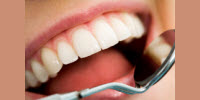Call (650) 525-0900
Dental Anxiety Is No Laughing Matter
We'd like to offer one comforting and wonderful fact about today's dentistry: it's much less stressful than it used to be.
Technology, new procedures, and some very sophisticated approaches to dental anesthesia have all contributed to comfortable dentistry, from cleaning to cavity preparations to root canals.
But what if you didn't grow up with modern dentistry, and remember it differently?
If you have had difficult dental experiences, you may be among the 150 million Americans who white-knuckle their way through treatment, or avoid the dentist altogether. The fact is, about 80% of the fearful can overcome dental phobia, with a little help from conscious sedation.
Many dentists understand dental fear and where it comes from. And many are becoming trained in forming good working relationships with fearful patients. Your dentist should encourage you to voice your anxiety and discuss your problems with him or her, before he or she touches a tooth in your mouth.
They should listen to your needs, and agree on small things that help you maintain a sense of control - a hand signal works with some patients. But talking about fear with your dentist - being assertive and letting him or her know what bothers you - is the first step.
If you're moderately anxious, the dental team can provide distracting diversions to put those concerns to rest. If you're extremely anxious, they can virtually put anxiety to rest via oral sedation. This approach involves taking a mild sedative before you arrive for your appointment. You remain awake, but extremely relaxed - so relaxed that many patients have all their needed dental work completed in a single office visit. If dental anxiety has kept you from making an appointment you know is needed - a sedation dentist can help!
Call for an appointment:
(650) 525-0900
Make an Appointment
Special Offer! Get free Zoom Whitening upon completion of a full cosmetic makeover!
Don't Forget to Floss!
Clean between teeth daily with floss or an interdental cleaner. Decay-causing bacteria can hid between teeth where toothbrush bristles can't reach. Flossing helps remove plaque and food particles from between teeth and under the gum line.






